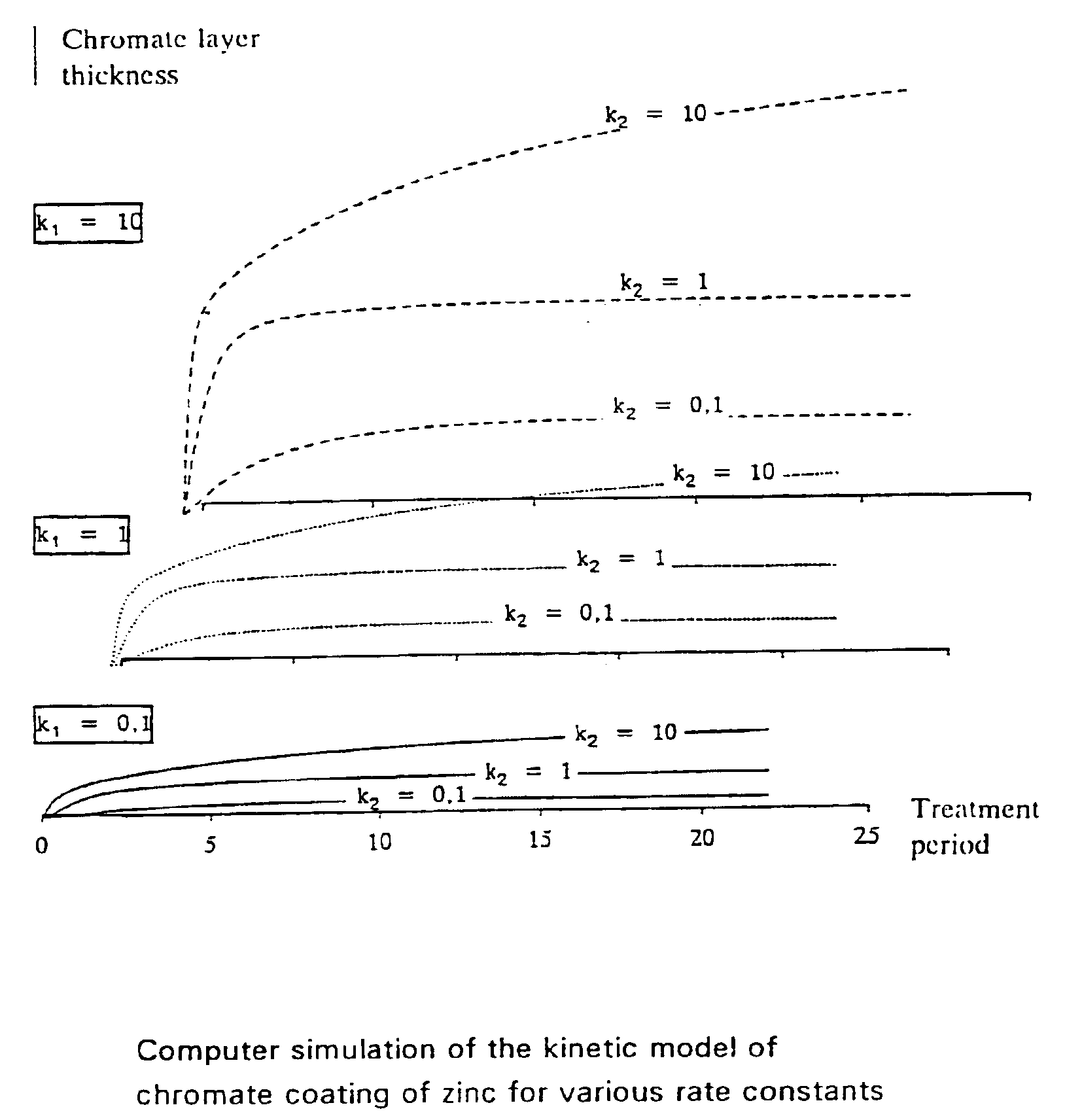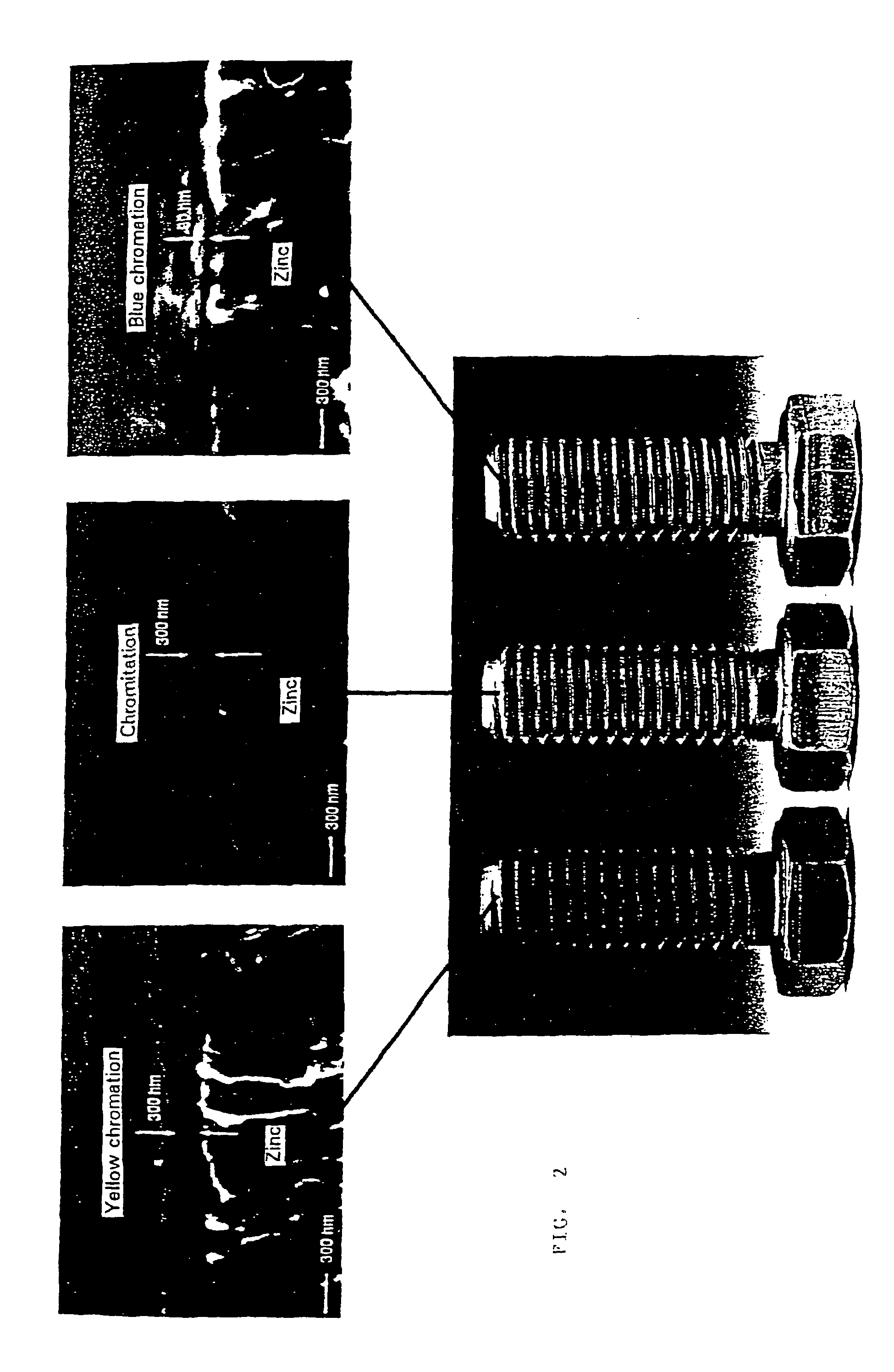Chromium (VI)-free conversion layer and method for producing it
a conversion layer and chromium (vi) technology, applied in the direction of electrolytic coatings, surface reaction electrolytic coatings, electrolytic coatings, etc., can solve the problems of optical deterioration of a component due to environmental influences, corrosive attack on the zinc layer, and further delay of the corrosion of the base metal
- Summary
- Abstract
- Description
- Claims
- Application Information
AI Technical Summary
Problems solved by technology
Method used
Image
Examples
example 1
[0058]The following experiment was carried out:
[0059]Small steel parts were bright-zinc coated electrolytically (approx. 15 m) and, following galvanisation, singly immersed in a boiling (approx. 100° C.), aqueous solution containing:
100 g / l CrCl3·6 H2O (trivalent chromium salt)
100 g / l NaNO3
15.75 g / l NaF
26.5 g / l citric acid·1 aq
which had previously been adjusted to a pH value of 2.5 with sodium hydroxide solution. The immersion time was 30 s. The parts were then rinsed with water and dried in air flow. On the parts a greenish, strongly iridescent layer had formed which later on turned out to be comprised of zinc / chromium oxide. In the corrosion test in the salt spray cabinet according to DIN 50021 SS it was surprisingly found that the chromate layer formed presented a spectacular corrosion protection until the appearance of first corrosion products of 1000 h according to DIN 50961 Chapter 10, in particular Chapter 10.2.1.2.
[0060]The novel greenish chromate layer had a layer thickness...
example 2
[0091]Electrolytically bright-zinc coated (15 m) steel parts were immersed in an aqueous chromate coating solution containing:
50 g / l CrCl3·6 H2O (trivalent chromium salt)
100 g / l NaNO3
31.2 g / l malonic acid
the pH of which had previously been adjusted to 2.0 with sodium hydroxide solution. The immersion time was 60 s. Following rinsing and drying there resulted in the salt spray cabinet according to DIN 50021 SS a corrosion protection of 250 h until first attack according to DIN 50961.
[0092]Malonic acid is a ligand enabling more rapid ligand replacement kinetics at the chromium(III) than the fluoride of Example 1. Good corrosion protection by far exceeding the minimum requirement of DIN 50961 for Method Group C (yellow chromation) may thus already be achieved at 60° C.
example 3
[0093]Electrolytically bright-zinc coated (15 m) steel parts were immersed in an aqueous chromate coating solution consisting of:
50 g / l CrCl3·6 H2O (trivalent chromium salt)
3 g / l Co(NO3)2
100 g / l NaNO3
31.2 g / l malonic acid
previously adjusted to pH 2.0 with sodium hydroxide solution. Immersion time was 60 s. Following rinsing and drying there resulted in the salt spray cabinet according to DIN 50021 SS a corrosion protection of 350 h until first attack according to DIN 50961.
[0094]Cobalt is an element which was capable, in accordance with the model concept, of catalysing ligand replacement and moreover reducing reverse reaction II owing to insertion of kinetically stable oxides into the chromate layer, so that the chromate layer altogether should become thicker. In this point, as well, the model concept established for the present invention is verified under practical conditions. Corrosion protection could once more clearly be enhanced in comparison with Example 3 by nothing but the a...
PUM
| Property | Measurement | Unit |
|---|---|---|
| thickness | aaaaa | aaaaa |
| thickness | aaaaa | aaaaa |
| thickness | aaaaa | aaaaa |
Abstract
Description
Claims
Application Information
 Login to View More
Login to View More - R&D
- Intellectual Property
- Life Sciences
- Materials
- Tech Scout
- Unparalleled Data Quality
- Higher Quality Content
- 60% Fewer Hallucinations
Browse by: Latest US Patents, China's latest patents, Technical Efficacy Thesaurus, Application Domain, Technology Topic, Popular Technical Reports.
© 2025 PatSnap. All rights reserved.Legal|Privacy policy|Modern Slavery Act Transparency Statement|Sitemap|About US| Contact US: help@patsnap.com



